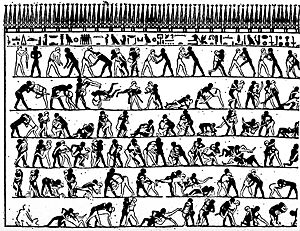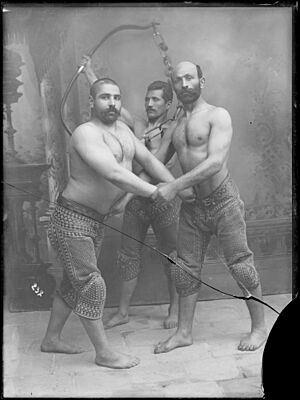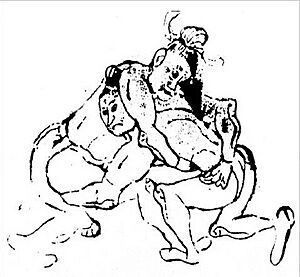History of wrestling facts for kids
Wrestling and grappling sports have a very long history. They go back to prehistoric times! Many old forms of wrestling still exist today. These are often called folk wrestling. More formal wrestling styles have also been created. They are part of many martial arts around the world. In these arts, grappling is a big part of fighting without weapons.
The modern history of wrestling became popular in the 1800s. This led to new sports like Greco-Roman wrestling in Europe. In Great Britain and the United States, freestyle wrestling and collegiate wrestling developed. These sports were hugely popular around 1900. In the 1920s, show wrestling, now called professional wrestling, became separate from competitive sport wrestling, known as amateur wrestling.
Contents
Ancient Wrestling Styles
Wrestling is a natural human activity. It is like a pretend fight or a way for males to show off. Even some apes wrestle! The oldest pictures of wrestling are from 15,000 to 20,000 years ago in southern France. Cave paintings in Mongolia from 7000 BC also show men wrestling with crowds watching.
In Ancient Mesopotamia, a type of belt wrestling was popular very early on. A stone carving from about 3000 BC shows three pairs of wrestlers. A bronze statue from around 2600 BC shows two figures in a wrestling hold. This statue is one of the oldest pictures of sports.
Pictures of martial arts sports in Ancient Egypt started around 2400 BC. In one tomb, six pairs of boys are shown wrestling. More evidence for wrestling in Egypt comes from Beni Hasan (around 2000 BC). Here, wrestling scenes cover large parts of tomb walls. Later Egyptian art also showed Egyptian and Nubian wrestlers competing. Many moves seen in modern freestyle wrestling can be found in these ancient Egyptian pictures.
Written descriptions of wrestling appear in old stories. These include the Greek and Sanskrit epics. The Mahabharata describes a fight between two strong wrestlers, Bhima and Jarasandha.
Shuai Jiao is a legendary Chinese wrestling style. The Yellow Emperor supposedly used it in a big battle. This early style was called jiao di, meaning "butting with horns."
Greek wrestling was a popular martial art. Wrestlers scored points by making their opponent's back touch the ground. They also scored by forcing an opponent out of the ring. Three falls decided the winner. This sport was part of the Olympics from 704 BC. Wrestling is described in famous Greek stories like the Iliad and the Odyssey. Wrestlers were also shown on vases, sculptures, and coins. The ancient Greeks made wrestling a formal tournament. A single winner would emerge from many competitors. Even the famous philosopher Plato was known for wrestling in the Isthmian games.
Wrestling continued to be popular in the Hellenistic period. Egyptian kings Ptolemy II and Ptolemy III were shown as winning wrestlers. When the Romans conquered the Greeks, they adopted Greek wrestling. It became Roman Wrestling during the Roman Empire. By the 800s, the Byzantine emperor Basil I was said to have won a wrestling match against a strong Bulgarian wrestler.
Celtic wrestling has a long history too. Wrestling was mentioned in the Tailteann Games in Ireland, which date back thousands of years. Different styles like Cornish wrestling and Gouren likely came from a common old style.
Medieval and Early Modern European Wrestling
Wrestling was widely practiced throughout medieval Europe. Both nobles and common people enjoyed it. It stayed popular during the Renaissance and into the 1500s. In 1520, at a famous meeting called the Field of the Cloth of Gold, King Francis I of France wrestled King Henry VIII of England. Francis threw Henry in a wrestling match.
The German school of fencing has records of wrestling masters from the 1400s and 1500s. They specialized in fighting without weapons. This unarmed combat was split into two types. One was sportive grappling, called geselliges ringen. This had rules and was for fun. It usually ended with a throw or a submission. The other was serious unarmed combat, called kampfringen. This was for duels or self-defense. Kampfringen included punches, joint-locks, elbow strikes, chokeholds, headbutts, and some kicks.
One important person who shaped kampfringen was Ott Jud from Austria. He created a grappling system for combat. It included joint breaks, arm locks, and throws meant to cause serious injury. Other books from that time also included wrestling techniques.
Later, during the Baroque period, upper classes stopped wrestling. It became more of a hobby for people in the countryside. This led to the many different forms of European folk wrestling we see today.
Wrestling in the Middle East
Many of the world's oldest pictures of wrestling are from the Middle East. Carvings and statues show that belt wrestling existed there long ago. Wrestling is also mentioned in old stories like the epics of Gilgamesh and the Shahnameh. Oil wrestling, popular today in Turkey, was recorded in ancient Sumeria and Babylon.
In Persia (modern-day Iran), traditional grappling called koshti was practiced by everyone. It was for sport and for battle training. In special training halls called zourkhaneh, soldiers practiced exercises and grappling. This tradition is now called Varzesh-e bastani. Ancient Iranian combat-wrestling included grabs, punches, and low kicks. As Iranian influence spread, this practice was adopted in India as Pehlwani.
Wrestling in Asia
Chinese Wrestling
In Ancient China, stories describe Chi You using punches, elbow strikes, and kicks in wrestling tournaments. Classical Chinese wrestling, or jiao li, was a public sport in the Qin Dynasty (221-207 BC). It was held for entertainment and to find the best fighters. Wrestlers fought on a raised platform called a lei tai. They had to push their opponent off or make them give up with arm-locks (chin-na). Wrestlers traditionally wore belts for gripping. The name shuai jiao was chosen in 1928 when competition rules became standard.
Indian Subcontinent Wrestling
Wrestling in India was divided into four types. These ranged from sport (malakride) to combat (malla-yuddha). Mughal conquerors brought more ground fighting, calling their style kusti (now pehlwani). Wrestlers still compete on dirt floors, wearing only a loincloth, much like in ancient times.
Japanese Wrestling
The term jūjutsu was created in the 1600s. It became a general name for many grappling styles in Japanese martial arts. Before that, these skills had different names. Some names meant "short sword grappling," "grappling," "body art," or "softness." The systems of unarmed combat from before 1573 are now called Japanese old-style jujutsu.
Modern Wrestling History
How Modern Wrestling Developed
The Lancashire wrestling style from England may have led to Catch wrestling. The Scots created a version called Scottish Backhold. This style focused only on taking an opponent down, with no ground fighting. The Irish developed the "collar-and-elbow" style, which later came to the United States.
Modern wrestling as a sport grew in the 1800s from these folk wrestling traditions. Two main styles emerged: "freestyle" and "Greco-Roman" wrestling. These are now part of "amateur wrestling" in the modern Olympics.
A tradition of mixing wrestling with showmanship started in France in the 1830s. Showmen presented wrestlers with exciting names. They challenged people to try and beat them for money. In 1848, Jean Exbroyat formed the first modern wrestling circus group. He set a rule: no holds below the waist. He called this "flat hand wrestling." This new style quickly spread across Europe. It was known as Greco-Roman, Classic, or French wrestling.
The Golden Age of Wrestling (1890–1914)
By the late 1800s, Greco-Roman wrestling became very popular in Europe. With more gyms and athletic clubs, both Greco-Roman and modern freestyle wrestling became formal sports. Big prize money was offered in European Greco-Roman tournaments. Freestyle wrestling grew fast in the United Kingdom and the United States.
A "Golden Age" for the sport followed. It ended when World War I started in 1914. In 1898, Paul Pons from France became the first Professional World Champion. Leading wrestlers like Georg Hackenschmidt and Frank Gotch were like popular heroes.
In the United States, Martin Burns and his student, Frank Gotch, were dominant. Burns was known for winning almost all of his 6,000 matches. He also trained great wrestlers, including Gotch. Gotch became one of America's first sports superstars. He was the first to truly claim the world's heavyweight championship. He beat European champion Georg Hackenschmidt in 1908 and 1911. These are seen as very important matches in wrestling history.
During this time, professional wrestlers took part in both real competitions and shows. These shows focused more on entertainment. Wrestling was introduced as part of variety acts to make strongman shows more exciting. This period saw the start of the split between "professional wrestling" (entertainment) and "amateur wrestling" (competition). Georg Hackenschmidt, a world champion, learned showmanship. He wrestled many matches for entertainment, not just sport. This showed the future of sports entertainment.
The separation of "worked" (purely performative, choreographed) wrestling from competitive sport began in the 1920s. This more entertaining style was brought to British wrestling. Amateur wrestler Sir Atholl Oakeley and Henry Irslinger started a promotion using this new style, called "All-in wrestling". Because of high demand, many promoters switched to more violent styles. These included weapons and chair shots. Women wrestlers and mud-filled rings also became common. In the late 1930s, professional wrestling was banned in London.
Greco-Roman wrestling was included in the First Modern Olympic Games in Athens in 1896. After missing the 1900 Olympics, sport wrestling returned in 1904 in St. Louis. This time it was freestyle competition. Since then, both Greco-Roman and freestyle wrestling have been part of the Olympics. Women's freestyle was added in 2004.
Mid to Late 20th Century Wrestling
Wrestling's popularity dropped a lot from 1915 to 1920. This was partly due to World War I. Also, its reputation suffered in America because people doubted if it was a real sport.
After Frank Gotch retired, professional wrestling in the United States lost popularity. Three professional wrestlers, Ed Lewis, Billy Sandow, and Toots Mondt, formed their own promotion in the 1920s. They changed their in-ring product to attract fans. They were called the "Gold Dust Trio" because they made a lot of money. This marked the start of "professional wrestling" as an entertainment business. It brought back public interest in wrestling between the two World Wars. However, wrestling did not become as popular as it was before the war. Boxing became more popular during its own "Golden Age."
Since 1921, the International Federation of Associated Wrestling Styles (FILA) has regulated amateur wrestling. In 1928, the NCAA published rules for collegiate wrestling. The first NCAA Wrestling Team Championship took place that year. Collegiate wrestling became a unique American sport. College and high school wrestling grew, especially after the NCAA rules were standardized. More schools started offering wrestling matches and tournaments. There were breaks during World War II. But in high schools, state wrestling championships began in the 1930s and 1940s. As amateur wrestling grew after World War II, more wrestlers moved from high school to college competition.
Both freestyle wrestling and American collegiate wrestling did not have a scoring system to decide matches without a fall until the NCAA introduced points in the 1940-1941 season. This also influenced international styles. By the 1960s, international wrestling matches were scored by three secret judges. They made the final decision by raising colored paddles. In the late 1950s, Dr. Albert deFerrari pushed for a visible scoring system. He also wanted a rule for a "controlled fall." This would only count a fall if the offensive wrestler caused it. These changes were soon adopted internationally for Greco-Roman and freestyle wrestling.
See also
- History of martial arts
- folk wrestling








